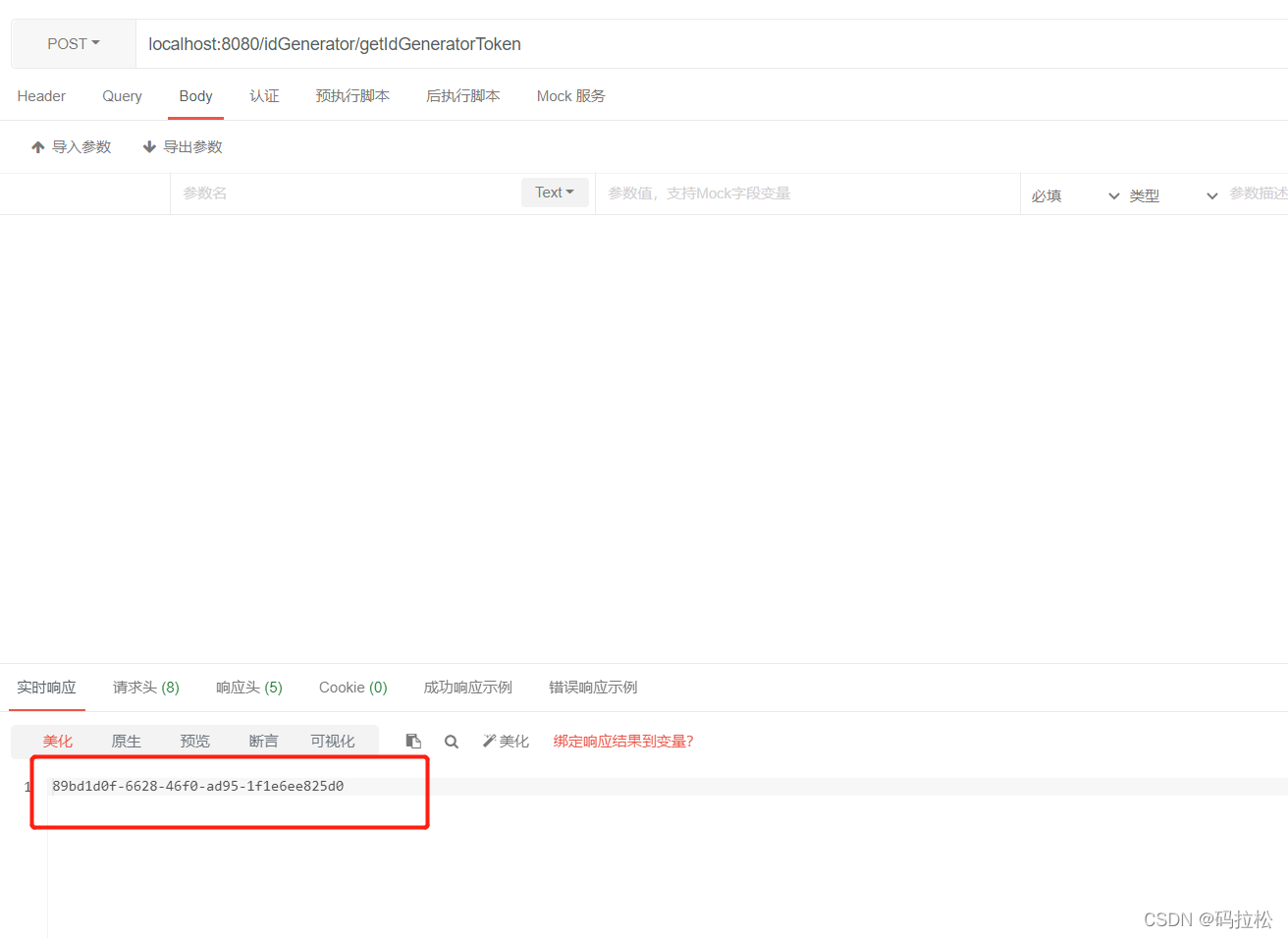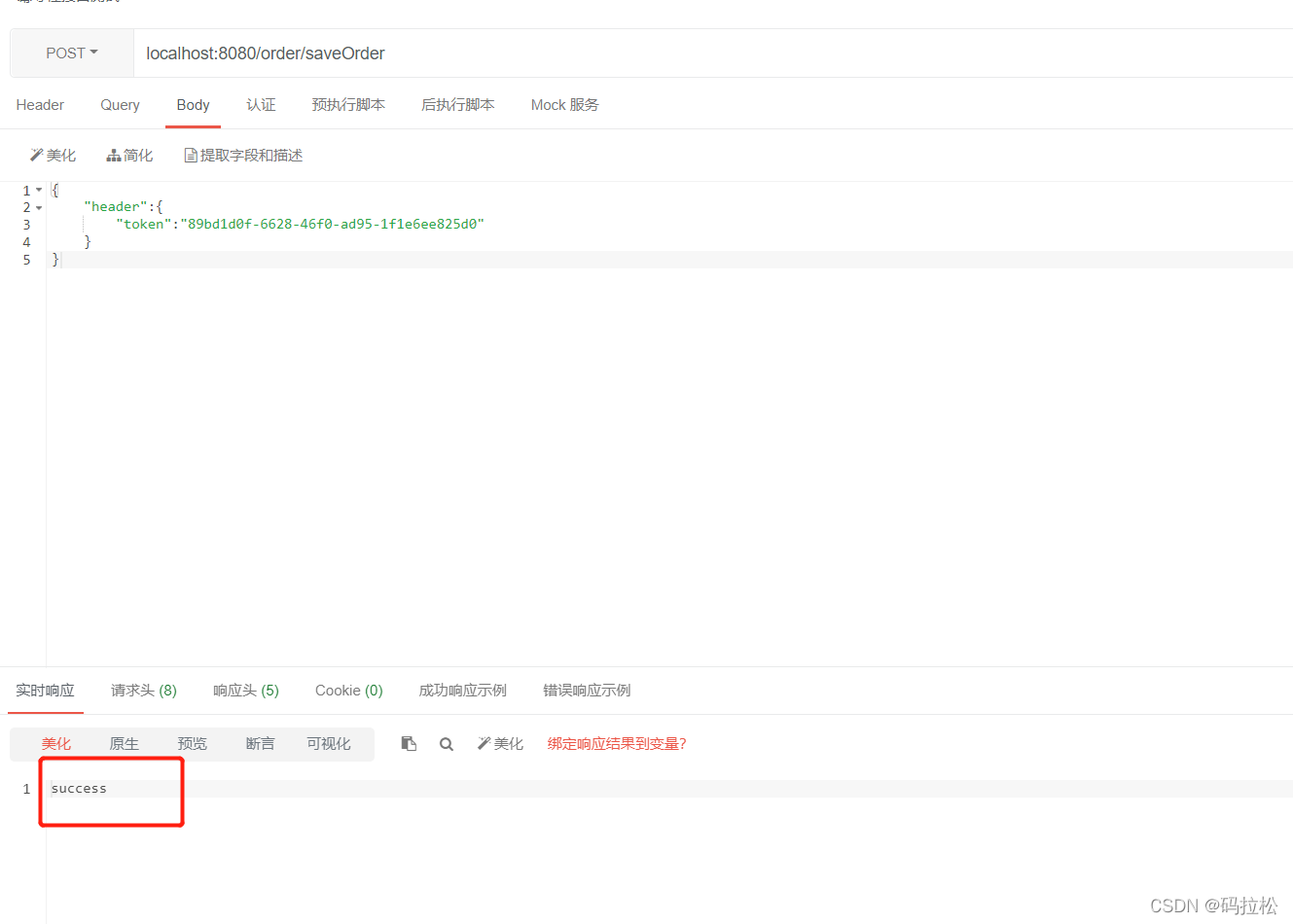- 1首起针对国内金融企业的开源组件投毒攻击事件_组件投毒 数据库
- 2项目体检(Health Check)升级上线
- 3Mac系统安装及配置python_macbook如何安装python2
- 4python读程序写结果-31.Python:文件读写
- 5Git+TortoiseGit详细安装教程(HTTP方式)_tortoisegit http
- 6Python的日志输出_python日志输出到文件
- 7Springboot+Vue项目-基于Java+MySQL的图书馆管理系统(附源码+演示视频+LW)
- 8阅读小车循迹论文笔记:灰度传感器、仿生处理器、路径跟踪机制()_灰度传感器原理图
- 9SIDE:开启研发新的颠覆式的开发体验
- 10Flask-SQLAlchemy的使用(详解)_flask sqlalchemy options
一个注解实现接口幂等性,真心优雅!_幂等注解
赞
踩
一、什么是幂等性?
简单来说,就是对一个接口执行重复的多次请求,与一次请求所产生的结果是相同的,听起来非常容易理解,但要真正的在系统中要始终保持这个目标,是需要很严谨的设计的,在实际的生产环境下,我们应该保证任何接口都是幂等的,而如何正确的实现幂等,就是本文要讨论的内容。
二、哪些请求天生就是幂等的?
首先,我们要知道查询类的请求一般都是天然幂等的,除此之外,删除请求在大多数情况下也是幂等的,但是ABA场景下除外。
举一个简单的例子
比如,先请求了一次删除A的操作,但由于响应超时,又自动请求了一次删除A的操作,如果在两次请求之间,又插入了一次A,而实际上新插入的这一次A,是不应该被删除的,这就是ABA问题,不过,在大多数业务场景中,ABA问题都是可以忽略的。
除了查询和删除之外,还有更新操作,同样的更新操作在大多数场景下也是天然幂等的,其例外是也会存在ABA的问题,更重要的是,比如执行update table set a = a + 1 where v = 1这样的更新就非幂等了。
最后,就还剩插入了,插入大多数情况下都是非幂等的,除非是利用数据库唯一索引来保证数据不会重复产生。
三、为什么需要幂等
1.超时重试
当发起一次RPC请求时,难免会因为网络不稳定而导致请求失败,一般遇到这样的问题我们希望能够重新请求一次,正常情况下没有问题,但有时请求实际上已经发出去了,只是在请求响应时网络异常或者超时,此时,请求方如果再重新发起一次请求,那被请求方就需要保证幂等了。
2.异步回调
异步回调是提升系统接口吞吐量的一种常用方式,很明显,此类接口一定是需要保证幂等性的。
3.消息队列
现在常用的消息队列框架,比如:Kafka、RocketMQ、RabbitMQ在消息传递时都会采取At least once原则(也就是至少一次原则,在消息传递时,不允许丢消息,但是允许有重复的消息),既然消息队列不保证不会出现重复的消息,那消费者自然要保证处理逻辑的幂等性了。
四、实现幂等的关键因素
关键因素1
幂等唯一标识,可以叫它幂等号或者幂等令牌或者全局ID,总之就是客户端与服务端一次请求时的唯一标识,一般情况下由客户端来生成,也可以让第三方来统一分配。
关键因素2
有了唯一标识以后,服务端只需要确保这个唯一标识只被使用一次即可,一种常见的方式就是利用数据库的唯一索引。
五、注解实现幂等性
下面演示一种利用Redis来实现的方式。
推荐一个开源免费的 Spring Boot 实战项目:
1.自定义注解
import java.lang.annotation.ElementType; import java.lang.annotation.Retention; import java.lang.annotation.RetentionPolicy; import java.lang.annotation.Target; @Target(value = ElementType.METHOD) @Retention(RetentionPolicy.RUNTIME) public @interface Idempotent { /** * 参数名,表示将从哪个参数中获取属性值。 * 获取到的属性值将作为KEY。 * * @return */ String name() default ""; /** * 属性,表示将获取哪个属性的值。 * * @return */ String field() default ""; /** * 参数类型 * * @return */ Class type(); }
- 1
- 2
- 3
- 4
- 5
- 6
- 7
- 8
- 9
- 10
- 11
- 12
- 13
- 14
- 15
- 16
- 17
- 18
- 19
- 20
- 21
- 22
- 23
- 24
- 25
- 26
- 27
- 28
- 29
- 30
- 31
2.统一的请求入参对象
@Data public class RequestData<T> { private Header header; private T body; } @Data public class Header { private String token; } @Data public class Order { String orderNo; }
- 1
- 2
- 3
- 4
- 5
- 6
- 7
- 8
- 9
- 10
- 11
- 12
- 13
- 14
- 15
- 16
- 17
- 18
- 19
- 20
- 21
- 22
3.AOP处理
import com.springboot.micrometer.annotation.Idempotent; import com.springboot.micrometer.entity.RequestData; import com.springboot.micrometer.idempotent.RedisIdempotentStorage; import org.aspectj.lang.ProceedingJoinPoint; import org.aspectj.lang.annotation.Around; import org.aspectj.lang.annotation.Aspect; import org.aspectj.lang.annotation.Pointcut; import org.aspectj.lang.reflect.MethodSignature; import org.springframework.stereotype.Component; import javax.annotation.Resource; import java.lang.reflect.Method; import java.util.Map; @Aspect @Component public class IdempotentAspect { @Resource private RedisIdempotentStorage redisIdempotentStorage; @Pointcut("@annotation(com.springboot.micrometer.annotation.Idempotent)") public void idempotent() { } @Around("idempotent()") public Object methodAround(ProceedingJoinPoint joinPoint) throws Throwable { MethodSignature signature = (MethodSignature) joinPoint.getSignature(); Method method = signature.getMethod(); Idempotent idempotent = method.getAnnotation(Idempotent.class); String field = idempotent.field(); String name = idempotent.name(); Class clazzType = idempotent.type(); String token = ""; Object object = clazzType.newInstance(); Map<String, Object> paramValue = AopUtils.getParamValue(joinPoint); if (object instanceof RequestData) { RequestData idempotentEntity = (RequestData) paramValue.get(name); token = String.valueOf(AopUtils.getFieldValue(idempotentEntity.getHeader(), field)); } if (redisIdempotentStorage.delete(token)) { return joinPoint.proceed(); } return "重复请求"; } } import org.aspectj.lang.ProceedingJoinPoint; import org.aspectj.lang.reflect.CodeSignature; import java.lang.reflect.Field; import java.util.HashMap; import java.util.Map; public class AopUtils { public static Object getFieldValue(Object obj, String name) throws Exception { Field[] fields = obj.getClass().getDeclaredFields(); Object object = null; for (Field field : fields) { field.setAccessible(true); if (field.getName().toUpperCase().equals(name.toUpperCase())) { object = field.get(obj); break; } } return object; } public static Map<String, Object> getParamValue(ProceedingJoinPoint joinPoint) { Object[] paramValues = joinPoint.getArgs(); String[] paramNames = ((CodeSignature) joinPoint.getSignature()).getParameterNames(); Map<String, Object> param = new HashMap<>(paramNames.length); for (int i = 0; i < paramNames.length; i++) { param.put(paramNames[i], paramValues[i]); } return param; } }
- 1
- 2
- 3
- 4
- 5
- 6
- 7
- 8
- 9
- 10
- 11
- 12
- 13
- 14
- 15
- 16
- 17
- 18
- 19
- 20
- 21
- 22
- 23
- 24
- 25
- 26
- 27
- 28
- 29
- 30
- 31
- 32
- 33
- 34
- 35
- 36
- 37
- 38
- 39
- 40
- 41
- 42
- 43
- 44
- 45
- 46
- 47
- 48
- 49
- 50
- 51
- 52
- 53
- 54
- 55
- 56
- 57
- 58
- 59
- 60
- 61
- 62
- 63
- 64
- 65
- 66
- 67
- 68
- 69
- 70
- 71
- 72
- 73
- 74
- 75
- 76
- 77
- 78
- 79
- 80
- 81
- 82
- 83
4.Token值生成
import com.springboot.micrometer.idempotent.RedisIdempotentStorage; import com.springboot.micrometer.util.IdGeneratorUtil; import org.springframework.web.bind.annotation.RequestMapping; import org.springframework.web.bind.annotation.RestController; import javax.annotation.Resource; @RestController @RequestMapping("/idGenerator") public class IdGeneratorController { @Resource private RedisIdempotentStorage redisIdempotentStorage; @RequestMapping("/getIdGeneratorToken") public String getIdGeneratorToken() { String generateId = IdGeneratorUtil.generateId(); redisIdempotentStorage.save(generateId); return generateId; } } public interface IdempotentStorage { void save(String idempotentId); boolean delete(String idempotentId); } import org.springframework.data.redis.core.RedisTemplate; import org.springframework.stereotype.Component; import javax.annotation.Resource; import java.io.Serializable; import java.util.concurrent.TimeUnit; @Component public class RedisIdempotentStorage implements IdempotentStorage { @Resource private RedisTemplate<String, Serializable> redisTemplate; @Override public void save(String idempotentId) { redisTemplate.opsForValue().set(idempotentId, idempotentId, 10, TimeUnit.MINUTES); } @Override public boolean delete(String idempotentId) { return redisTemplate.delete(idempotentId); } } import java.util.UUID; public class IdGeneratorUtil { public static String generateId() { return UUID.randomUUID().toString(); } }
- 1
- 2
- 3
- 4
- 5
- 6
- 7
- 8
- 9
- 10
- 11
- 12
- 13
- 14
- 15
- 16
- 17
- 18
- 19
- 20
- 21
- 22
- 23
- 24
- 25
- 26
- 27
- 28
- 29
- 30
- 31
- 32
- 33
- 34
- 35
- 36
- 37
- 38
- 39
- 40
- 41
- 42
- 43
- 44
- 45
- 46
- 47
- 48
- 49
- 50
- 51
- 52
- 53
- 54
- 55
- 56
- 57
- 58
- 59
5. 请求示例
调用接口之前,先申请一个token,然后带着服务端返回的token值,再去请求。
import com.springboot.micrometer.annotation.Idempotent; import com.springboot.micrometer.entity.Order; import com.springboot.micrometer.entity.RequestData; import org.springframework.web.bind.annotation.RequestBody; import org.springframework.web.bind.annotation.RequestMapping; import org.springframework.web.bind.annotation.RestController; @RestController @RequestMapping("/order") public class OrderController { @RequestMapping("/saveOrder") @Idempotent(name = "requestData", type = RequestData.class, field = "token") public String saveOrder(@RequestBody RequestData<Order> requestData) { return "success"; } }
- 1
- 2
- 3
- 4
- 5
- 6
- 7
- 8
- 9
- 10
- 11
- 12
- 13
- 14
- 15
- 16
- 17
请求获取token值。

带着token值,第一次请求成功。

第二次请求失败。

版权声明:本文为CSDN博主「码拉松」的原创文章,遵循CC 4.0 BY-SA版权协议,转载请附上原文出处链接及本声明。原文链接:https://blog.csdn.net/CSDN_WYL2016/article/details/122993086
更多文章推荐:
2.2,000+ 道 Java面试题及答案整理(2024最新版)
觉得不错,别忘了随手点赞+转发哦!



